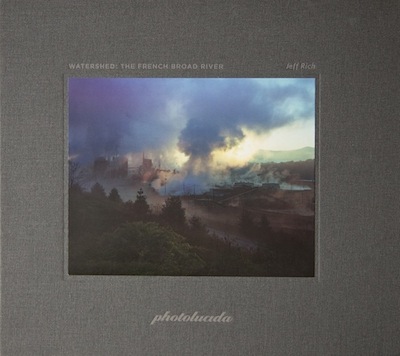Smoke and steam rise from the hollow of a lush valley as the morning sun ascends over the horizon, illuminating the sky in hues of gold, violet and cerulean blue. This is a sublime vision. It might seem as if I am describing a pastoral landscape painting by Thomas Cole or Albert Bierstadt. But in fact, I am describing a photograph made by Jeff Rich, and the steam lifting from the basin is not the product of daylight kissing the cool surface of a babbling brook. These vapors billow from the smoke stack of the Blue Ridge Paper Mill on the Pigeon River. In his new monograph, Watershed: The French Broad River, Jeff Rich uses beauty and craftsmanship to seduce his viewer into the troubling narrative associated with this great American waterway and it's tributaries, which have suffered catastrophic consequences associated with pollution and human negligence.
Jeff Rich takes his viewer on a journey beginning at the headwaters of the French Broad River. The first photograph depicts a pristine waterfall and a beautiful landscape free of human intervention. He shows us a river that is simultaneously used for the purpose of recreation and industry. There are photographs of families wading through shallow creeks, tourist groups riding ski lifts over rocky banks, and thrill seekers on canoes. These photographs become powerful because they exist in conversation with those that document the industrial entities that pollute the river. Rich shows us the power plants, factories, and mills that occupy the shoreline. One photograph depicts the carcasses of old cars that were used to reinforce a riverbank and prevent erosion. Another image shows a sewer pipeline running parallel and adjacent to a riverbank. Rich's images provide a vision that is concurrently beautiful and disheartening.
Rod Slemmons, curator at the Museum of Contemporary Photography in Chicago, wrote the introduction for Watershed. He approaches the images with empathy and a sense of nostalgia, correlating them to his own experience growing up on the Cuyahoga River in Northern Ohio. "We need to transcend the idea that rivers are barriers, potentially destructive competitors that get in our way." He suggests that humans ignore the rivers until they are needed. It makes sense that many of Rich's photographs depict bridges and pipelines. They are the structures designed to separate us from the river. In this way, his photographs emphasize the fissure between the consumption and origin of our most valuable resource.
Hartwell Carson, French Broad Riverkeeper, contributed a second essay to Watershed. He discusses the history of the river and how attitudes toward its management have changed since it was occupied by the Cherokee. Most importantly, he details how the Clean Water Act of 1972, and the formation of the Waterkeeper Alliance, has placed the French Broad River on the course toward recovery.
This small (9"x10") coffee table book is handsomely bound in a charcoal linen fabric with a full color image inlaid on the front cover. The overall design is minimal, yet sophisticated, containing over forty beautifully reproduced color photographs. A map is printed in the back of the book, which provides information about where each of the photographs was made. Rich also provides an index of select photographs and the stories that are associated with each of them. I highly recommend this book to anyone, but especially to those that possess an interest in landscape photography designed to inspire political or environmental reform.
Watershed was featured in Issue 21 of Fraction. See it here.
Support the artist and Photolucida and order the book here.
Daniel W. Coburn is a photographer and graduate student at the University of New Mexico.
To view Daniel's photography, please visit his website. Daniel was featured in Fraction Issue 20.
Follow Daniel on Twitter : @danielwcoburn

